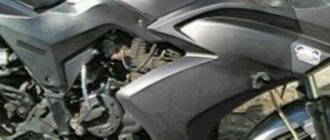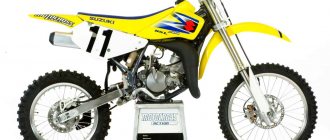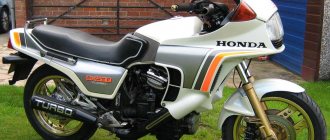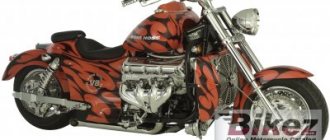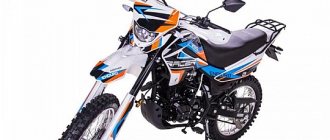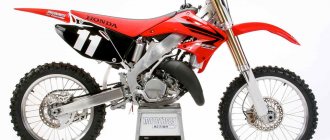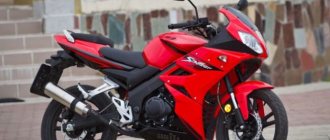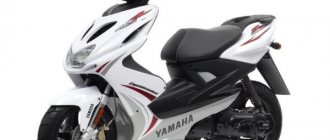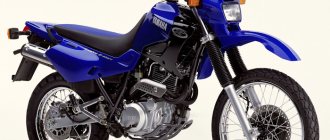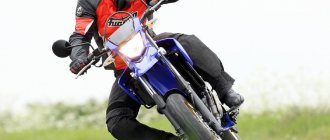Czech motorcyclesJawa motorcycles
Java 650 was very long-awaited for fans of the company.
Before it, the company produced only racing models and series in a small number of copies.
And then a magnificent representative appeared, created on the basis of the engine of the allied Austrian company Rotax. The first pilot version of the motorcycle was presented back in 2003 in the Czech Republic, where it caused a wave of emotions.
The contradictory opinions made the model the first PR campaign, which made the developers understand the genius of the project.
Java 650 retained many of its signature features, but also acquired new ones. There are several advantages of the model:
- The design of the motorcycle is created in such a way that a person can easily service it (candles, thermostat and other elements are conveniently located);
- The power unit and gearbox are pleasing with their characteristics even now, so many years after the model was released;
- The motorcycle has a simple and convenient design , and in general its execution is very successful;
The classic Jawa quality has been preserved , but the model also has several disadvantages:
- Instability of braking (the front shock absorber reaches its limit during moderate braking);
- In some phases of riding, the vibration of the engine increases (for a single-cylinder motorcycle this is natural, but the sensations are very strange while riding);
- Feedback from owners and experts conducting test drives revealed another problem: there are installation defects in the electrical equipment system (this does not create serious problems during further operation if you carefully monitor this).
Model 650 became popular not only in its homeland , as most copies were exported.
Thanks to its pleasant and simple controls, the motorcycle fell in love with the female audience. Although the men did not deprive him of attention.
What was especially pleasing about this Soviet model is that it has three variations .
Jawa 650 Classic
The Java 650 Classic, also known as the Police, defies definition.
Even the creator himself declared the model as something special and exceptional.
It comes closest to choppers, and its external characteristics interestingly combine traditional features and modern relevance.
The characteristics of the unit are perfect for travel lovers, and as an additional bonus you get an economical motorcycle with a trailed sidecar, which increases the overall load capacity significantly.
Like other motorcycles in the line, the Police is equipped with a single-cylinder Rotax Bombardier engine with a displacement of 650 cubic centimeters and a water cooling system.
The five-speed gearbox made a loud statement thanks to smooth gear changes and quiet, pleasant operation.
Safety is ensured by the semi-duplex steel body and good brakes. Jawa 650 Classic appeared earlier than its brothers, in 2004, and therefore is currently slightly outdated.
The very famous and popular at one time IZH Planet 2 - technical characteristics, description of the motorcycle you will find here.
IZH, which demonstrates excellent driving on the highway and on the roads:
The MXA WRECKING CREW crew rides a JAWA 75 500 HP bike.
MXA's Daryl adapted to the Jawa Speedway bike pretty quickly - forgetting everything he knew about riding a bike.
The MXA crash team loves bikes—all kinds of bikes—and we've tested and raced a lot of different types of dirt machines. We tested trackers, snowmobiles, strollers, pogo sticks, GNCC bikes, endurocross bikes, electric bikes, snowmobiles. Paris-Dakar bikes, ice and road racing in between our daily motocross bike testing. Yes, we know, it's not motocross - and that's what we like about it. It gives us a chance to see how the other half lives and have fun while doing it. Come with us as we try to tackle the smallest and easiest track we've ever tackled.
Speedway bicycles have an engine final drive. This makes transmission an important role in race setup.
What would go through your head if you climbed aboard a strange car and they told you to forget everything you knew about driving? This is the position MXA's disruptors found themselves in when world speedway champion Billy Hamill told us to "do everything that's the exact opposite of motocross." The MXA crew was thrown into a loop. Hey, we thought heading out for the day to ride a 500cc bike at Jawa Speedway was just pie. After all, it had two wheels, a steering wheel, drove through the mud and only turned left. How hard can it be?
We honestly didn't know anything about the Speedway other than watching a few YouTube videos (mostly compilations of crashes) and spending a few Friday nights at the Costa Mesa Fairgrounds with the gang watching the races. Truth be told, we thought we were golden. It looked simple: just flip it over, hit the gas, and use the brakes going into the corner. Not a good plan.
THERE WAS NO BRAKE, SHIFT LEVER, RADIATOR OR STROKE AND ONLY ONE USEFUL KNIFE. THERE WAS, HOWEVER, A 500 cc CZECHSLOVAK ENGINE. See, which produced 75 HORSES.
Czechoslovakian Jawa Speedway 500cc bike. The air-cooled CM is all skin and bones. With 75 horsepower and a 187-pound wet weight, the power-to-weight ratio will stretch your arms when you get on the gas.
At first there were no brakes. There was also no gear lever, no radiator, no shock absorber, no starter and only one usable running board. There was, however, a Czechoslovakian air-cooled, high-compression 500 cc engine. See, 75 horsepower. If it weren't for 1996 Speedway World Champion Billy Hamill, we'd have dropped the clutch, thrown our heads first into the wall and called it a day. Billy started racing at the Speedway at age 13, and at 16 he received his AMA Pro license. After several years of racing in the United States, Billy knew that in order to make a career at Speedway, he had to move to Europe. At 19, he received a contract to pursue his dream of becoming a world champion in one of the fastest, shortest and most controversial motorsports in the world. Currently semi-retired, Billy is a speedway coach/team manager.
Speedway racer Max Ruml was there to embarrass us.
Billy was there to keep us away from the scary outer wall. He told us to keep an open mind because the Speedway techniques were very different from the skills required for motocross. Yes, you need to torque the throttle, but without proper technique, torqueing the throttle will end up in the dreaded wall. Billy took baby steps by telling us about the fragile Jawa Speedway bike. He explained the dry clutch, the 23-inch rear wheel, the tiny forks, the weird bar bend and the proper stance.
As we got closer to the track we faced our next dilemma. WE FORGOT THAT THEY WASN'T HERE. STOPING REQUIRES A FLINSTONE ACT TO PULL YOUR LEGS.
Jawa 500cc 4 stroke single speed engine. The CM can go from zero to 60 in three seconds, but in our hands it tried to hit the wall in 2.5 seconds. All Speedway bikes run on methanol, and the gas tanks contain enough fuel to ride eight laps—about two minutes.
Billy's first job was to teach us how to ride a bike to a track that was a couple hundred feet away. First, we needed someone to help push the bike since it didn't have a kickstarter or neutral. All movement was controlled by a dry clutch. As we drove towards the highway, we realized that we couldn't turn right because our right leg would drag on the ground if we turned even a little to the right. The left footpeg didn't help either because it was very small and located at the front of the bike (one of our test riders mistook it for the gear lever). With both feet on the pegs, it felt like we were doing the splits. As we approached the track we were faced with our next dilemma. We forgot that there were no brakes. Stopping required the Flinstonian act of dragging your feet and using engine braking and quick clutch action to stop the bike.
Gino Manzares shows off his epic cornering style for the MXA crash team.
Once on the track, Billy gave us a rundown of what to do and we started making laps. We actually did eight laps because the bike wouldn't have enough gas before it ran out. Billy didn't interfere as we tried to solve our problems, drawing on his years of motocross experience. We tried several times to get into hot weather to get the rear end out, but we were unsuccessful. We were confident we could go faster on the KX450F with the handles. Once we exhausted our repertoire of motocross tricks, we were disappointed and came to get more fuel and talk to Billy. Now that we had learned the valuable lesson that a Speedway bike is not a motocross bike, Billy began instructing us on how to do things right.
Our short take on how to ride a bike on fast routes is: “turn right to go, speed up to slow down, and slow down to speed up.”
The speedway tracks are smooth. The forks of the driving links are spring-loaded with elastomer tapes.
Billy told us to slow down and concentrate on getting the rear end through the middle of the corner. He said that we should shift the throttle and put all our weight on the outside support through the middle of the corner. By weighing the outside peg we loosen the rear wheel and force it to float on smooth dirt. He said the rider should have a significant amount of extension in their right leg so that they shift their weight forward while standing on the bike with their left leg in front, sliding along the ground with their steel block.
This was much easier said than done because it was such an uncomfortable feeling when on the track. There was a big adrenaline rush needed to muster up the courage to break it. The motorcycle was so powerful that it caught your attention and the throttle was the key. You could spin the back wheel so fast you wouldn't even know it happened. Once we slowed down and worked on our technique, we started to get the hang of it. It was such a rush and incredibly fun. Our summary of how to ride a fast motorcycle is: "Turn right to go left, speed up to slow down, and slow down to speed up."
We asked Max Ruml to describe the Speedway for us. He said, “Well, you go from zero to 60 mph in 3 seconds with no brakes and throw it sideways the whole way around the corner.” Talk about an adrenaline junkie's dream! That's exactly what Max and Gino Manzares did to show us what it should look like. Watching these guys on the track was unreal. Speedway races consist of just four laps and take less than a minute to complete. Surprisingly, as soon as we picked up some speed, we were tired after four laps. We were lucky to have Billy Hamill guide us through our formative years on a speedway bike. He was smart enough to let us make every mistake in the book before trying to teach us anything. MXA's wrecking crew may not have been his best students, but every motorcycle enthusiast should give it a try at least once. For more speedway information, go to www.speedwaybikes.com.
>
Jawa 650 Style
The 2005 Best Product winner is beautiful, elegant and very carefully designed .
Not designed for short distance racing.
This motorcycle should completely suit your character : it is moderate, balanced, moves neatly and majestically.
The saddle is perfectly designed , you can sit on it all day long no matter what. The classic 17-liter tank will also please those who like to test their steel horse.
It is suitable for Russian users because it is designed for different climatic zones and sudden changes in weather conditions.
The main thing you should not forget is that this motorcycle was not created for off-road use . If you want to race on rough terrain, the Jawa 650 Style is not for you!
650 cc engine cm should not disappoint you.
Its power is 46 horses , the motorcycle can accelerate to 165 km/h , which is simply fantastic for its category. In the entire line, he is considered the most pampered and most beloved by developers.
Jawa 650 Dakar
A 2006 model that was a little ahead of its time. At the time of the presentation, many began to criticize the Dakar, saying that outwardly it is an enduro tourist, but in reality it is a city bike.
And besides, angular shapes came into fashion only a year or more later.
In terms of functionality, this model has no equal in the price segment: ergonomics at the highest level, good optics, a wide and comfortable saddle, reliable brakes and a powerful motor.
In principle, this is exactly the model about which it’s not a sin to say “for an amateur .
The Jawa 650 Dakar takes some getting used to. If this is your first bike, then you will not want to part with it for a very long time.
If you are switching from a newer and more expensive bike, the sensations are much more gray.
2021 Honda CRF1100L Africa Twin Unveiled
The current iteration of the Honda Africa Twin comes in two available variants: Africa Twin and Africa Twin Adventure Sports. The latter of which was more oriented towards off-road use, having increased suspension travel, a larger fuel tank and crash bars.
Next year, the positioning of the 2020 Honda Africa CRF1100L Twin will change slightly. The “Adventure Sports” modification will become more focused on full-fledged tourism, but the standard version, on the contrary, will be more suitable for off-road use.
Both models are based on a new engine with an increased volume of up to 1084 cm³. This was achieved by increasing the piston stroke by 5 mm. In addition, the cylinder heads have been modified, where the valve lift has increased, the throttle bodies have become larger in diameter, and the new arrangement of the injectors now provides a more direct spray of fuel into the combustion chamber.
Despite the fact that there are quite a lot of improvements, power has increased slightly, from 95 to 100.5 hp, and torque has increased by 6% and is now 104.9 Nm. In general, this is exactly what the end customers asked for, because everyone complained about the lack of power, including us.
Technical characteristics of Jawa 650 models
| Jawa 650 Classic | Jawa 650 Style | Jawa 650 Dakar | |
| Engine | Rotax | Rotax | Rotax |
| Number of cylinders/valves/stroke | 1/4/4 | 1/4/4 | 1/4/4 |
| Cooling system | Liquid (water) | Liquid (water) | Liquid (water) |
| Launch on account | Electric starter | Electric starter | Electric starter |
| Volume | 651.9 cc | 651.9 cc | 651.9 cc |
| Power | 48 l. With. / 6,500 rpm | 48 l. With. / 6,500 rpm | 48.1 l. With. / 6,500 rpm |
| checkpoint | Five steps | Five steps | Five steps |
| Gearbox type | Mechanics | Mechanics | Mechanics |
| Chassis | |||
| Suspension front/rear] | Telescopic fork 36 / Adjustable shock absorbers (2 pcs) | Telescopic fork 36 / Pendulum with adjustable shock absorbers (2 pcs) | Telescopic fork / Pendulum with mono-shock absorber |
| Suspension travel front/rear | 150/80 mm | 150/80 mm | 150/170 mm |
| Front braking system | Disc with two piston calipers (320 mm) | Hydraulic disc with two piston calipers (320 mm) | Hydraulic discs with two piston calipers (320 mm) |
| Rear braking system | Disc brake (220 mm) | Hydraulic disc (220 mm) | Hydraulic disc with two piston calipers (220 mm) |
| Dimensions | |||
| L/H/W | 2.215/0.718/1.130 m | 2.215/0.718/1.130 m | 2.215/0.718/1.130 m |
| Wheelbase | 1.525 m | 1.518 m | 1.518 m |
| Saddle height | 0.712 m | 0.820 m | 0.860 m |
| Weight (curb) | 187.5 kg | 190 kg | 195 kg |
| Price of a new copy | $ 3 600 | $ 3 700 | $8 000 |
| Used price | From $200 | From $700 | There is no information due to the low popularity of the model |
A stylish bike of limited production - Ural IMZ 8.1024 Cobra, which is now a collector's dream.
The basis for the creation of this motorcycle was the Ural classic model.
MY MOTORCYCLE
Java won the hearts of Soviet motorcycle enthusiasts a long time ago and is still popular. But who knows one of the modifications of this motorcycle - Java-500. How can this Yavushka differ from the others? This motorcycle is special in that it was originally produced for racing, but........
These were unusual races - ice racing - speedway. And Java-500 has conquered them more than once and shown excellent results.
Let's start in order: in the Soviet Union, they really started talking about motorcycle racing on ice in 1938 after the appearance of steel wire spikes. The first official competitions took place on March 13, 1939 at the Moscow Hippodrome. Then 35 participants took to the start. And in 1959, the first national championship in the 125 and 350 cm/cc motorcycle classes was held at the Grand Sports Arena of the Central Stadium in Luzhniki. Thanks to the climatic conditions, ice track racing has become very popular in our country. At the initiative of the motorcycle federations of the Soviet Union, Sweden and Czechoslovakia, the International Motorsports Federation (FIM) decided to organize an “ice” championship. The first such competitions took place in 1966, and our compatriot, the outstanding athlete Gabdarakhman Kadyrov, who competed at Java, became the champion. Since then, competitions of this rank have been held annually. But the most interesting thing is that all these years the leaders have been racing to the gold medal in the saddle of the same motorcycle - the Java 500. A rare example of athletic longevity! Especially for such an older motorcycle. So what kind of motorcycle is this that has held the lead for such a long time?
The first thing that catches your eye is the studded wheels. The height of the studs is limited to 28 mm and is carefully checked by the technical commission before races. But their number and location on the tire is individual for each athlete and averages up to 120 studs on the front wheel and up to 200 on the rear wheel. The front wheel is “shod” with a tire measuring 2.75X 23″ and installed in a telescopic fork, which is borrowed from the old model of the “Ch3” motocross bike. Its stroke is limited to 100 mm, the damping is changed accordingly and air is pumped into the feathers. The rear wheel with a 3.00X21″ tire on the latest model has a cantileve suspension with a central spring element and a travel of 60 mm. For the safety of the riders, the wheels are equipped with protection in the form of a tubular frame on the front and a deep fender on the rear, and the rear chain drive is covered with a shield.
The motorcycle engine is four-stroke, single-cylinder, air-cooled, cylinder diameter/piston stroke is 85/87 mm, displacement is 496 cm3, compression ratio is 13.5-13.8, power is 56 hp. With. at 8500 rpm, maximum torque - 50 Nm, fuel - methyl alcohol (methanol). The crankshaft is mounted on roller bearings of the “Java” design. The piston is forged from an aluminum alloy and has two 1 mm thick piston rings. Classic cylinder - cast iron liner and aluminum jacket. The cylinder head is a two-valve, single camshaft driven by a chain (the previous 891 model used a two-valve head with two camshafts). In the mid-seventies, more powerful four-valve engines appeared on race tracks, which led to more frequent falls and serious injuries to athletes. Therefore, the FIM introduced a ban on the use of four-valve engines in ice racing. The engine lubrication system consists of an oil tank installed in the warmest place - behind the cylinder, and a two-section pump. Oil is supplied by a pump to the connecting rod (lower) bearing and into the cavity of the gas distribution mechanism. The splashed oil lubricates the remaining engine parts (camshaft main bearings, chain, valves, camshaft needle bearings) and flows from the lower part of the crankcase into a separate reservoir, from which it is drained after one or two runs. Due to its simplicity and high quality manufacturing, the engine is very reliable. The service life of its main parts is approximately 25 races, that is, almost a whole season.
Ignition is from a magneto. The engine is equipped with a Dell'Orto PH BE 34DS carburetor with a diffuser diameter of 34 mm (FIM limitation). The motorcycle frame is welded from high-quality pipes and has high spatial rigidity, which is especially necessary in the final races of the competition, when the ice is heavily broken by spikes. Due to the impossibility of the studded wheel slipping at the start, the motorcycle is equipped with a two-speed gearbox. First gear is used only at start. Despite the high speeds that track motorcycles develop, they do not have brakes: braking is carried out by the engine. In the event of a fall, the ignition is turned off by pulling out a chip, which is connected by a cord to the driver’s right wrist. And another characteristic feature of ice racing motorcycles: the appearance of even the most modern models is very reminiscent of their “fifty-year-old” ancestors. This is a kind of “technical reserve”, but it does not in any way reduce the entertainment and excitement of the fight.
This seemingly “nondescript” Yavushka is still in demand.
Photo gallery
We have already become familiar with the Java 650 motorcycles, which in Soviet times were considered the best available. I must say that even now they are in considerable demand. Let's look at the legend of the motorcycle industry in our small photo selection.
